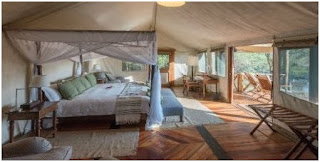Kavinga Safari Camp,
situated on a cliff in the southern sector of Mana Pools National Park,
Zimbabwe, opened in May.

The camp comprises
five spacious double or twin-bedded, en-suite tented units with verandas built
on raised platforms, offering a view of the rising sun over the mountains. The central living area has an upstairs wooden
deck with views over the waterhole and the Ruckomechi riverbed.
A stepped pathway
leads visitors down to the wildlife observation hide, which is built into the
ground to provide close-up water-level views.

Kavinga Safari Camp
also has guides on hand to offer a wilderness experience to wildlife
enthusiasts, walkers, hikers and photographers wanting to explore the Mana
Pools Park and World Heritage Site..





















